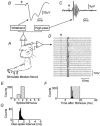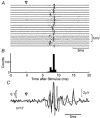EEG oscillations at 600 Hz are macroscopic markers for cortical spike bursts
- PMID: 12807983
- PMCID: PMC2343032
- DOI: 10.1113/jphysiol.2003.045674
EEG oscillations at 600 Hz are macroscopic markers for cortical spike bursts
Erratum in
- J Physiol. 2003 Aug 1;550(Pt 3):996
Abstract
The human electroencephalogram (EEG) is generated predominantly by synchronised cortical excitatory postsynaptic potentials oscillating at frequencies <100 Hz. Unusually, EEG responses to electrical nerve stimulation contain brief bursts of high-frequency (600 Hz) wavelets. Here we show, in awake monkeys, that a subset of primary somatosensory cortex single units consistently fires both bursts and single spikes phase-locked to EEG wavelets. Spike bursts were also evoked by tactile stimuli, proving that this is a natural response mode. EEG wavelets at 600 Hz may therefore permit non-invasive assessment of population spike timing in human cortex.
Figures




References
-
- Allison T, McCarthy G, Wood CC, Jones SJ. Potentials evoked in human and monkey cerebral cortex by stimulation of the median nerve. A review of scalp and intracranial recordings. Brain. 1991;114:2465–2503. - PubMed
-
- Baker SN, Lemon RN. Precise spatiotemporal repeating patterns in monkey primary and supplementary motor areas occur at chance levels. J Neurophysiol. 2000;84:1770–1780. - PubMed
-
- Baker SN, Philbin N, Spinks R, Pinches EM, Wolpert DM, MacManus DG, Pauluis Q, Lemon RN. Multiple single unit recording in the cortex of monkeys using independently moveable microelectrodes. J Neurosci Methods. 1999;94:5–17. - PubMed
-
- Baker SN, Pinches EM, Lemon SN. Synchronisation in monkey motor cortex during a precision grip task. II. Effect of oscillatory activity on corticospinal output. J Neurophysiol. 2003 (in the Press) - PubMed
-
- Baker SN, Spinks R, Jackson A, Lemon RN. Synchronization in monkey motor cortex during a precision grip task. I. Task dependent modulation in single-unit synchrony. J Neurophysiol. 2001;85:869–885. - PubMed
Publication types
MeSH terms
LinkOut - more resources
Full Text Sources

